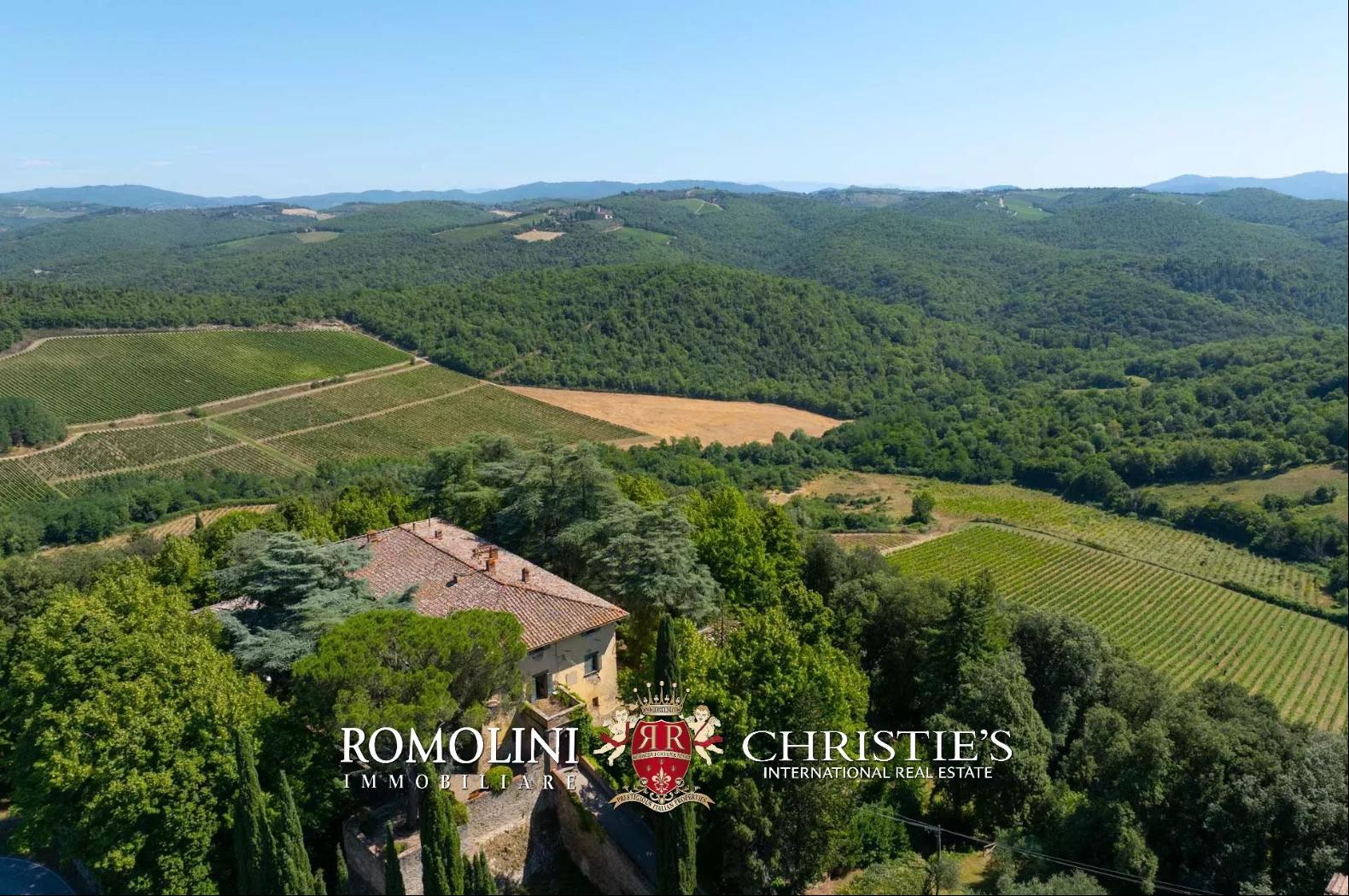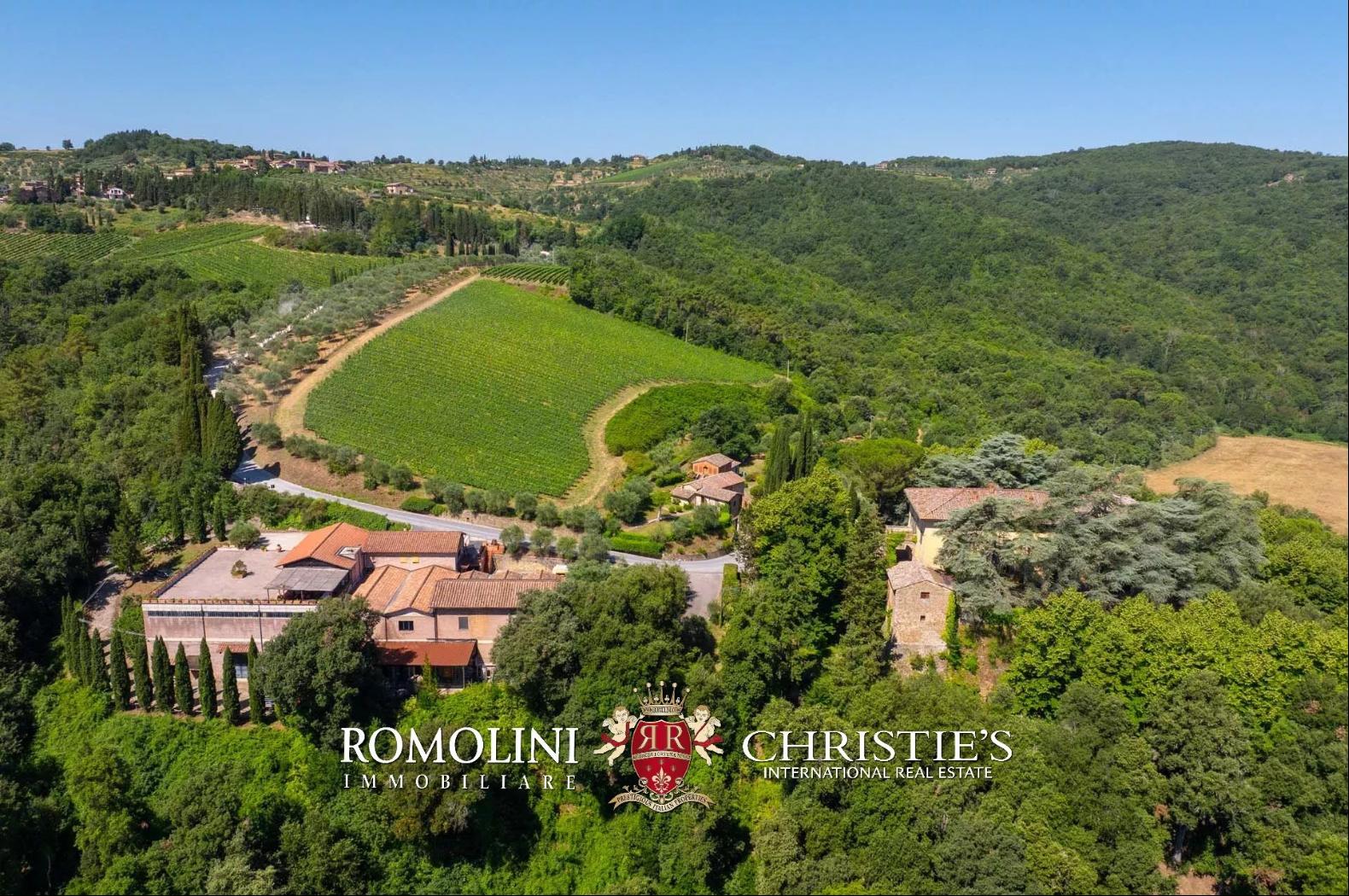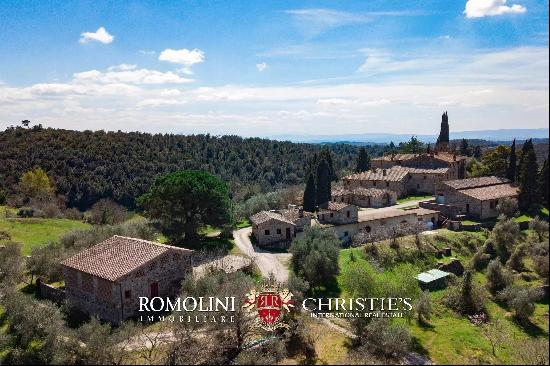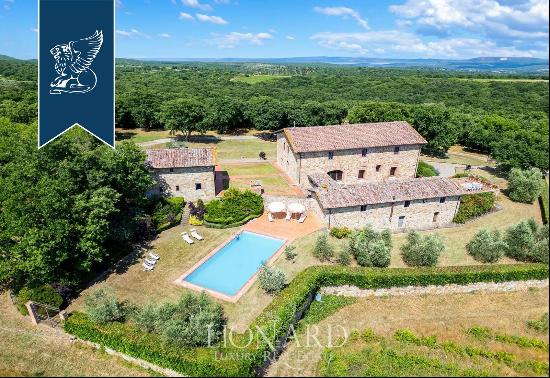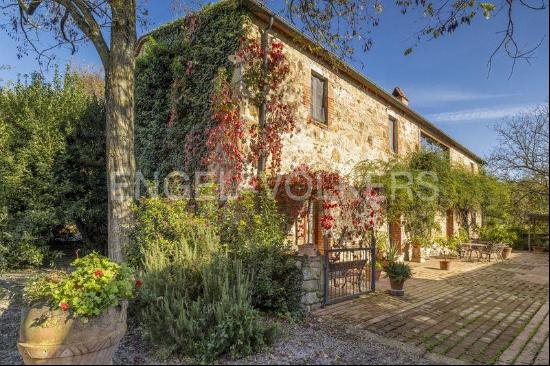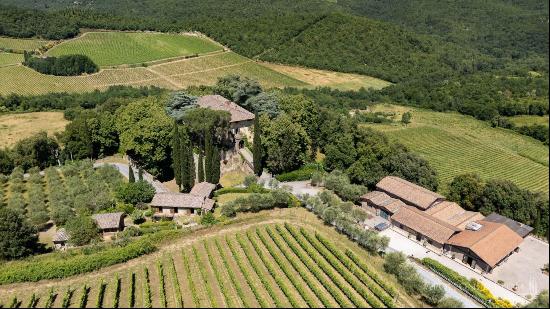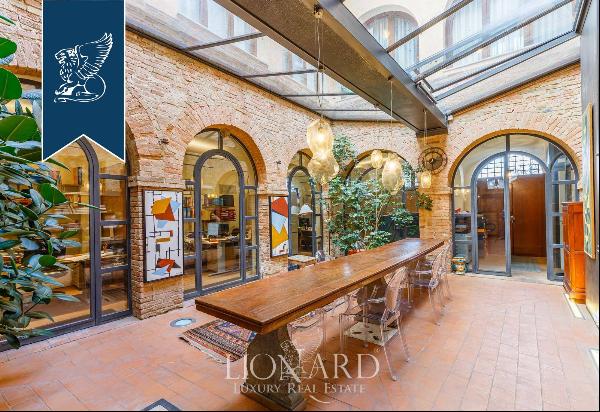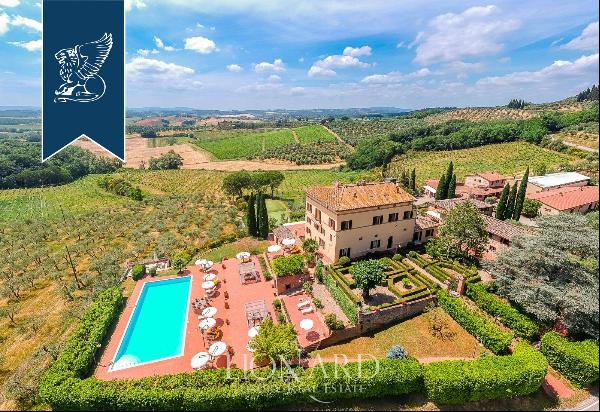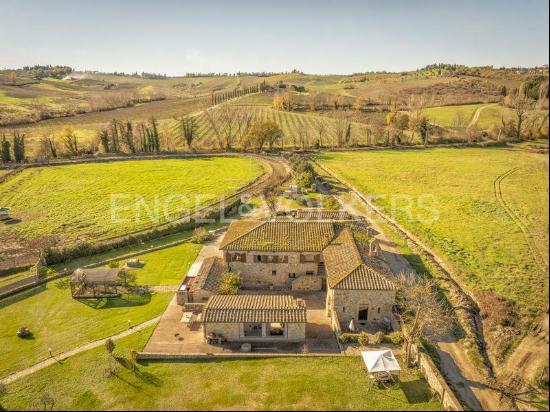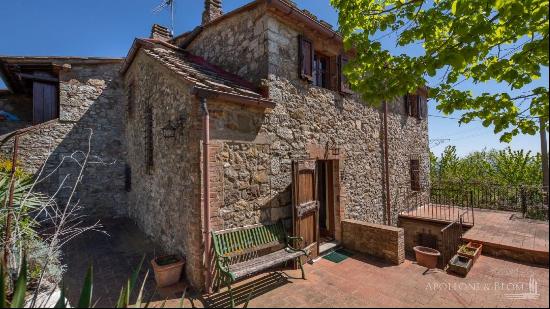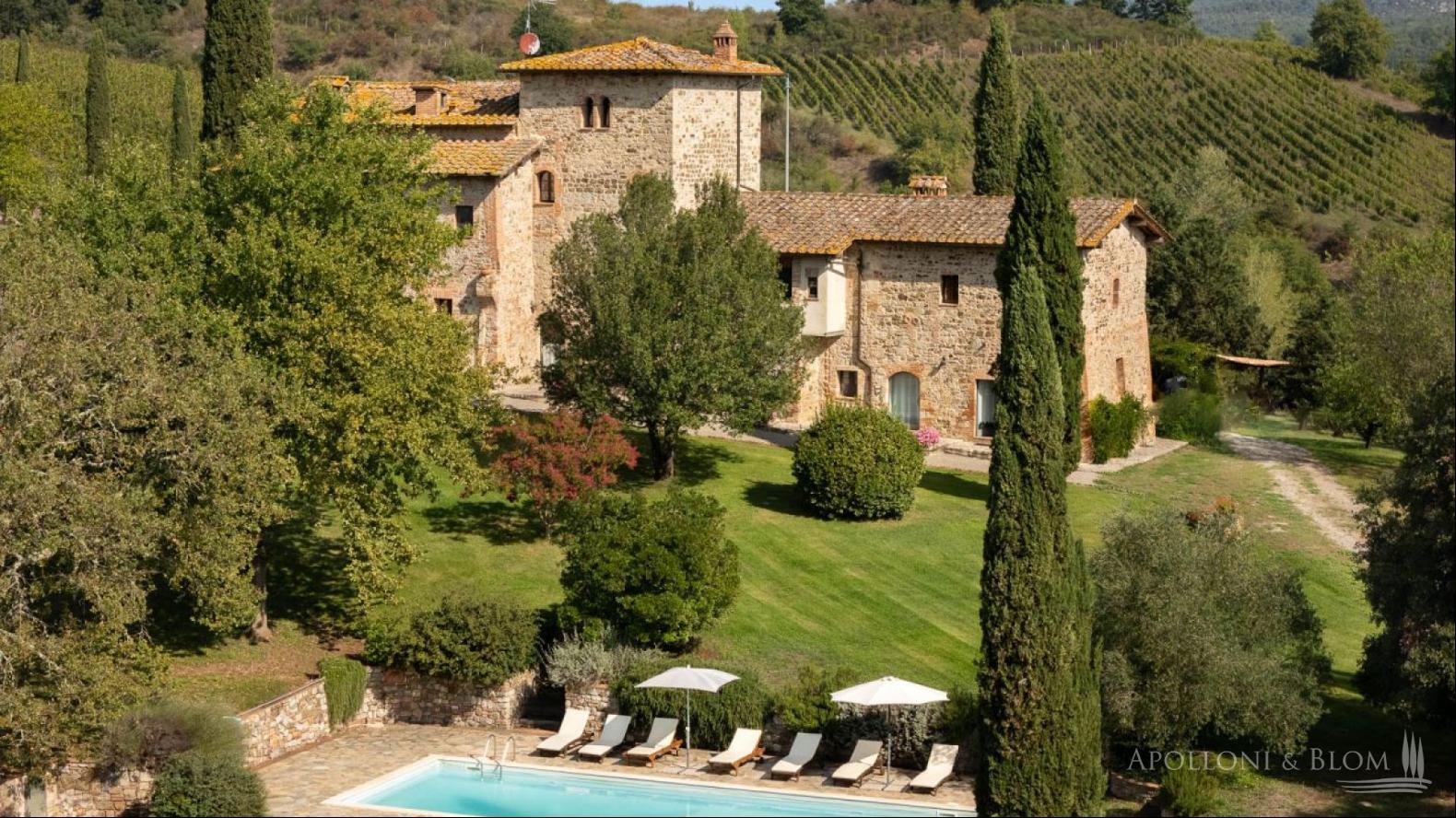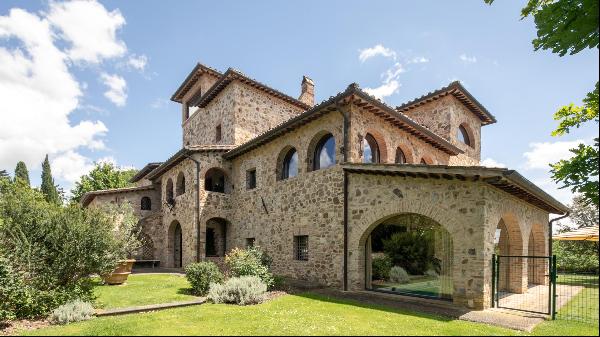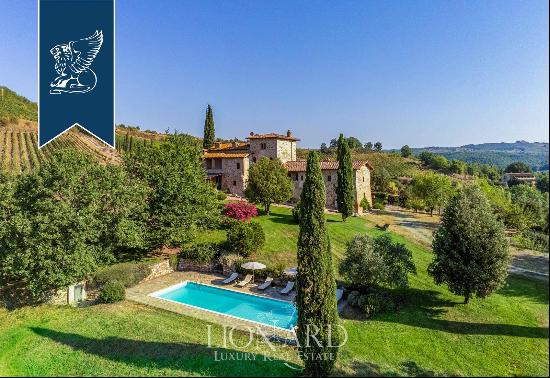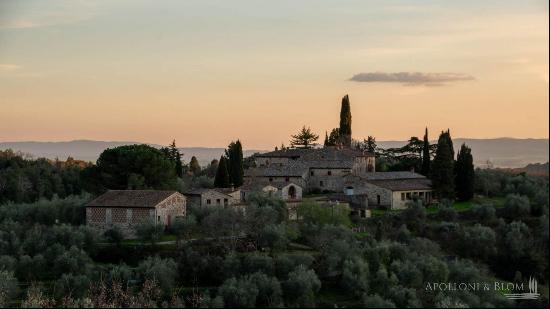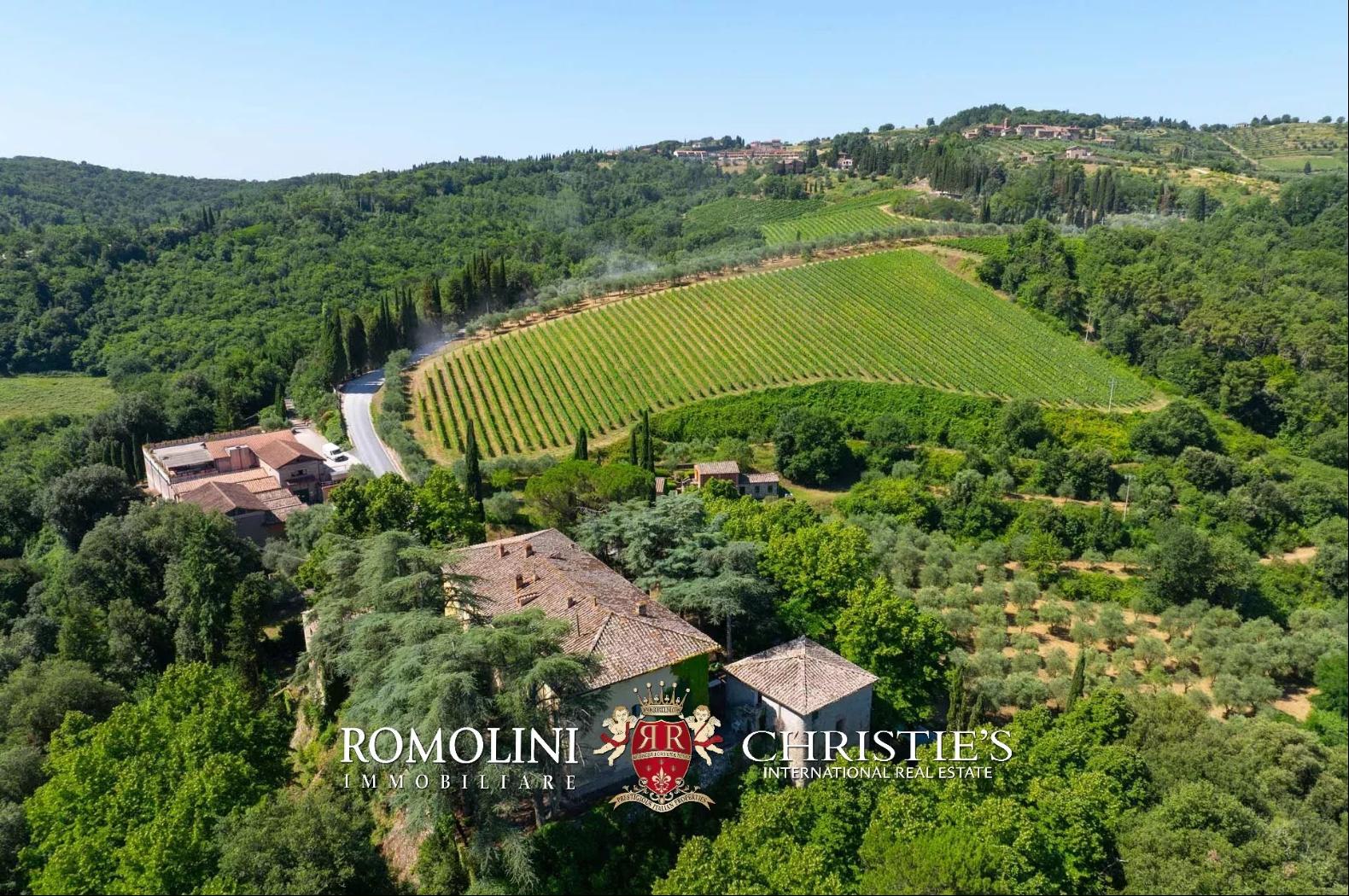
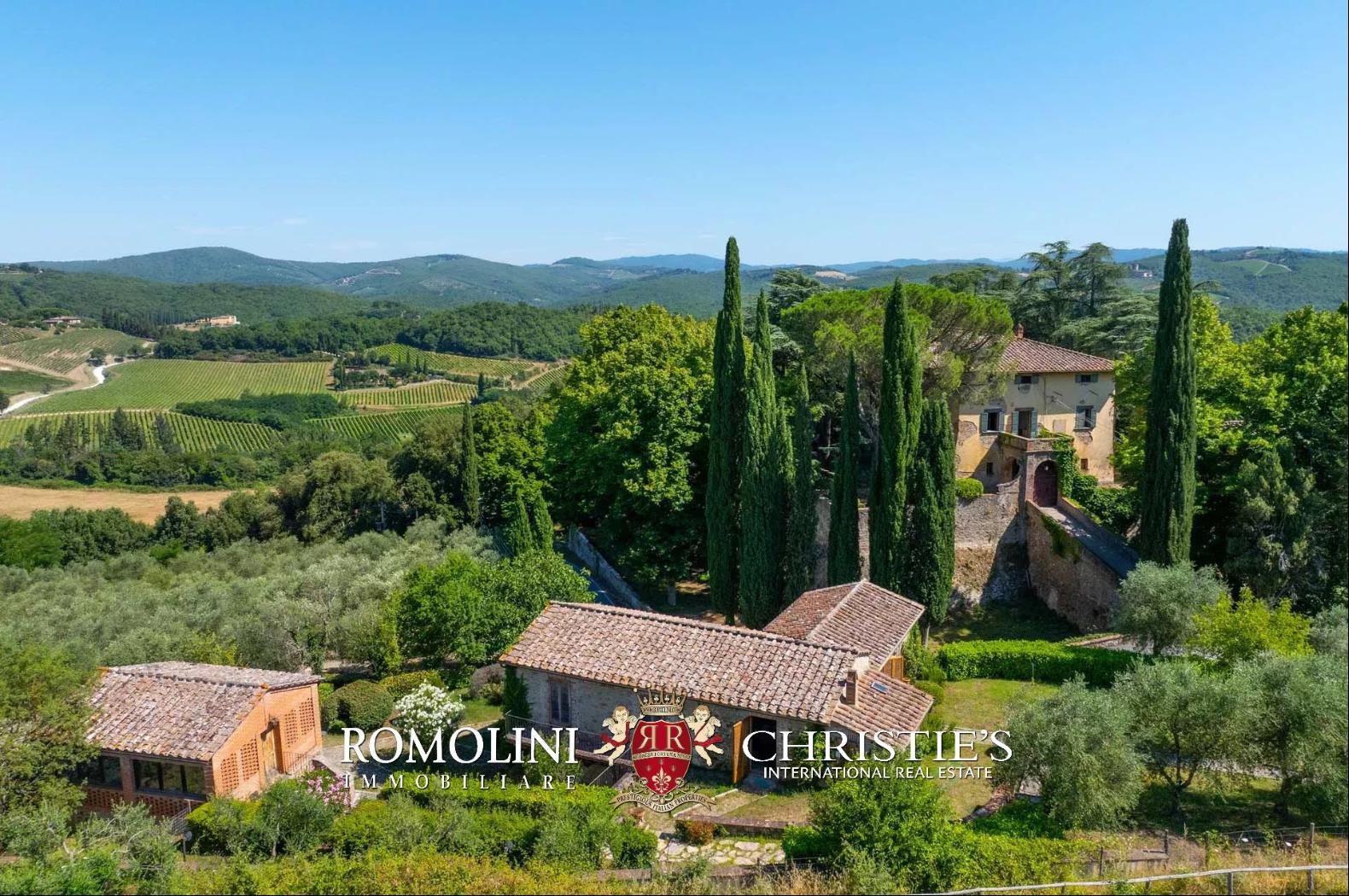
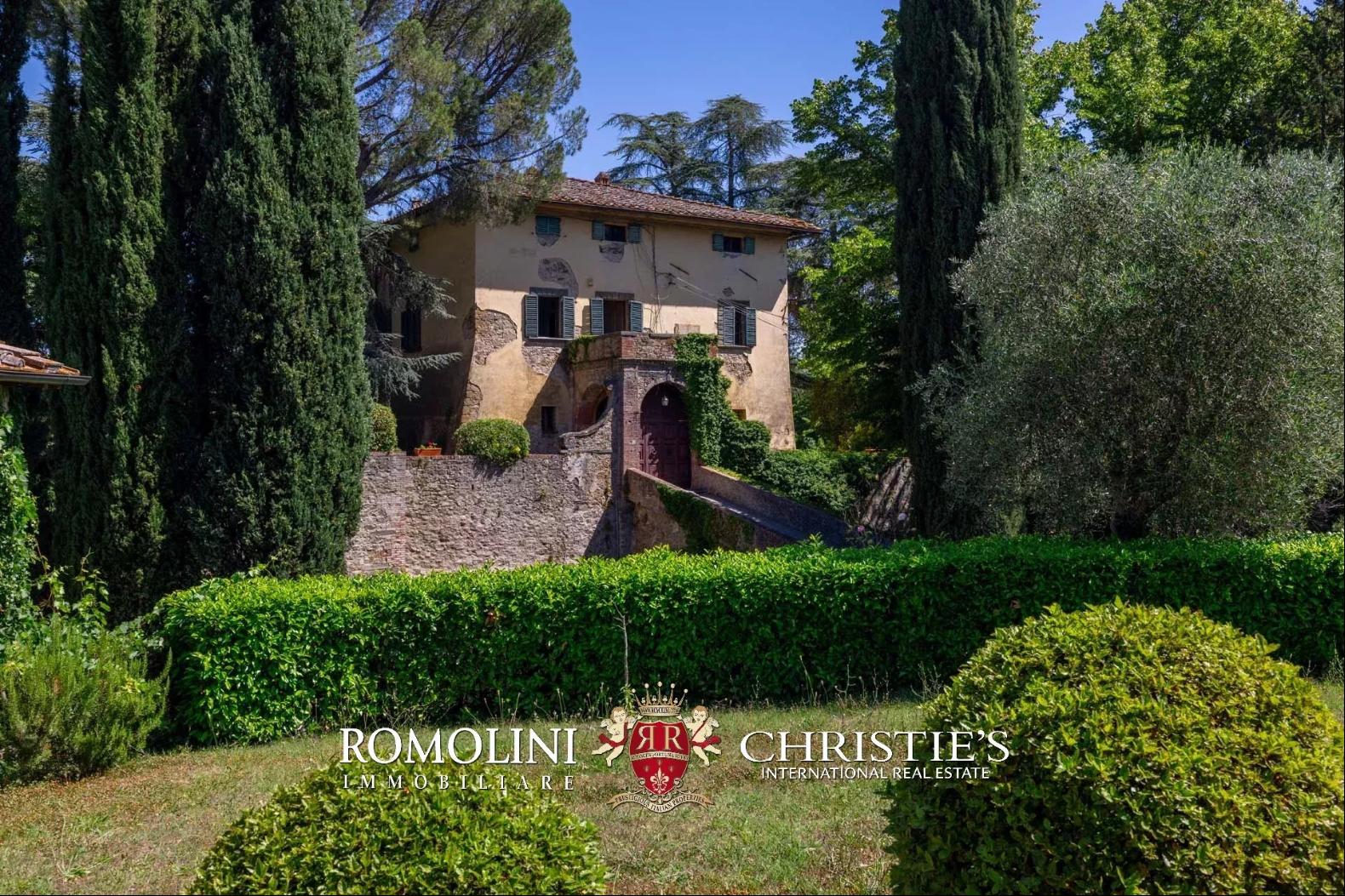
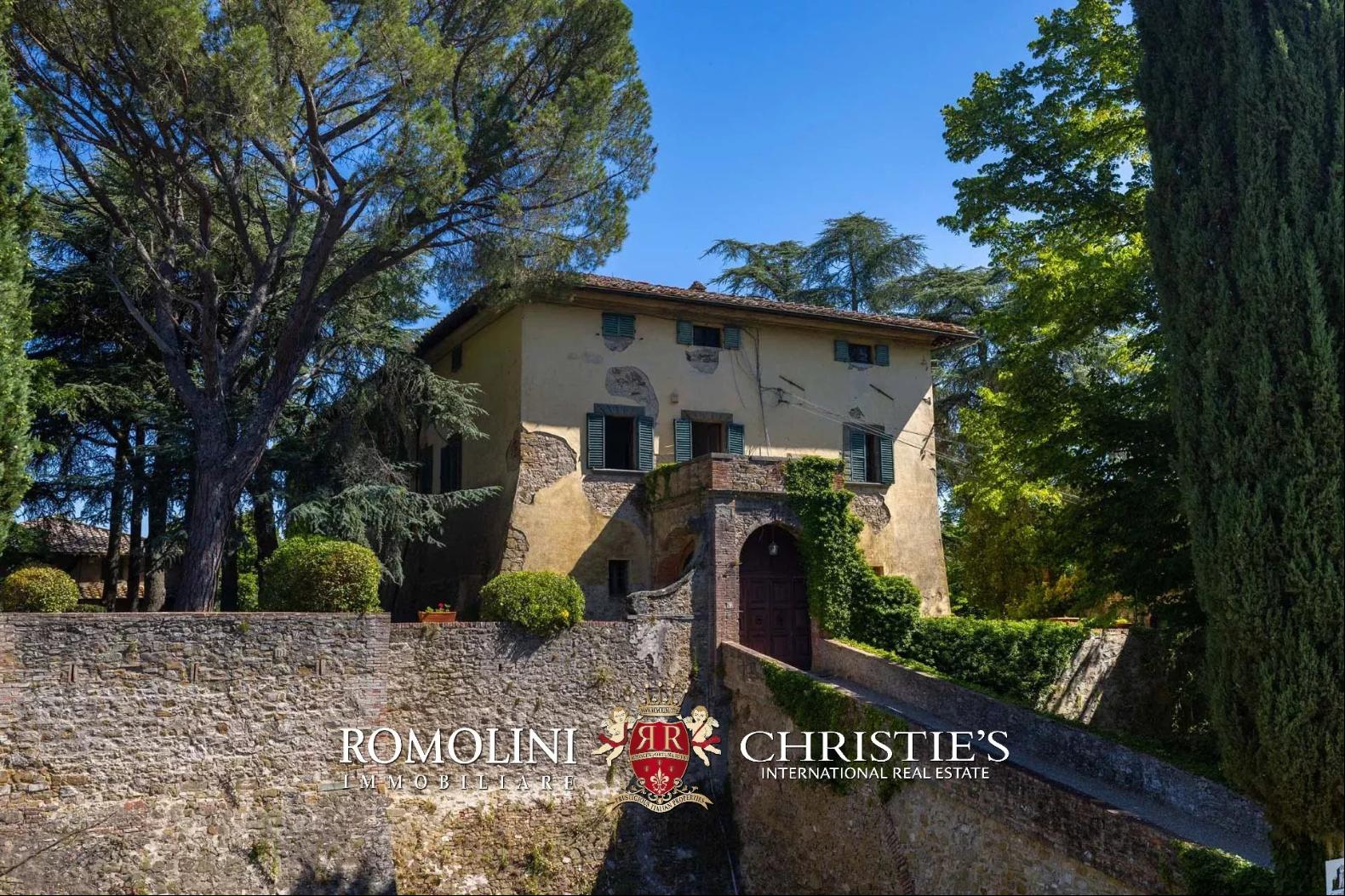
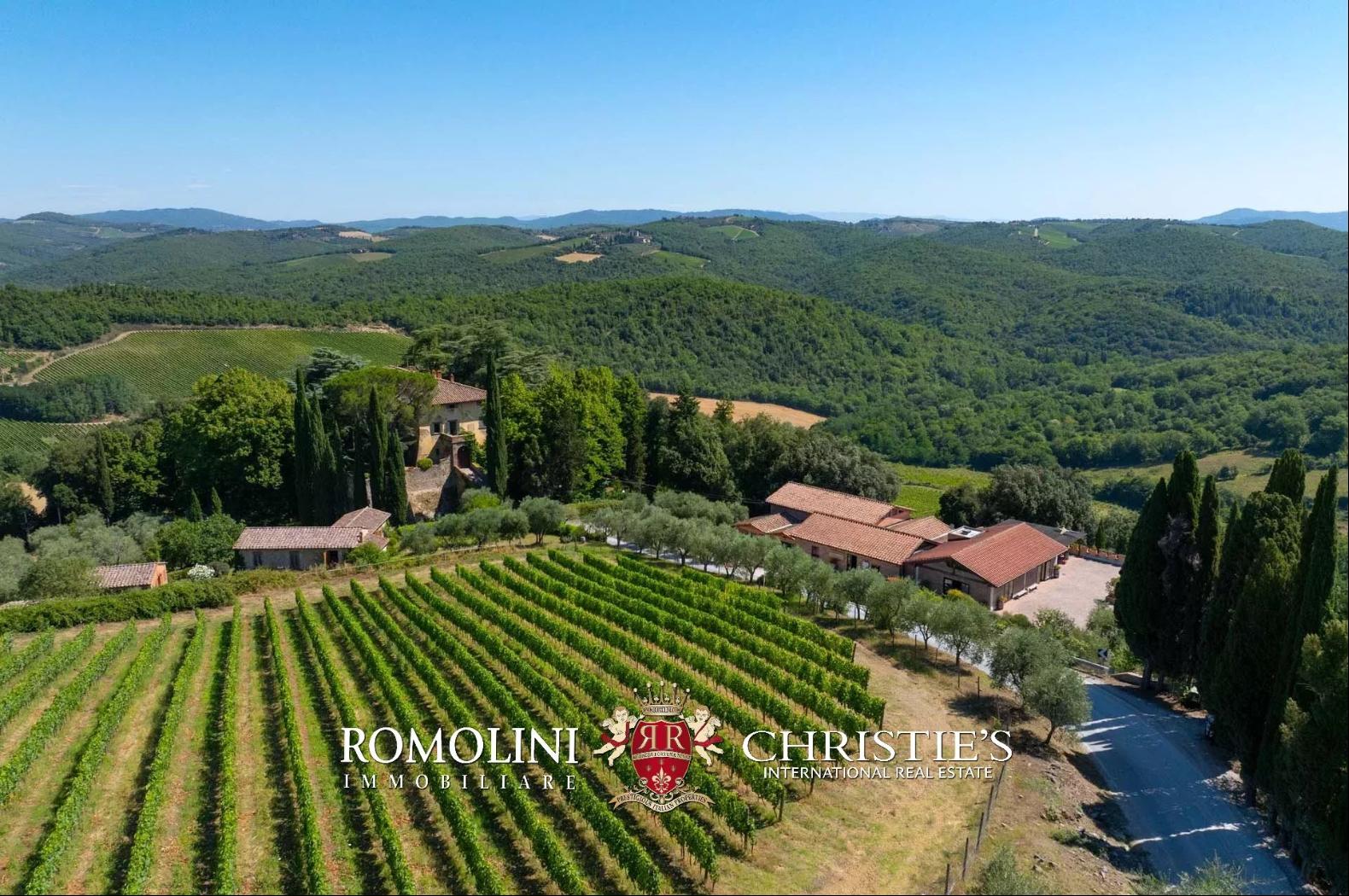
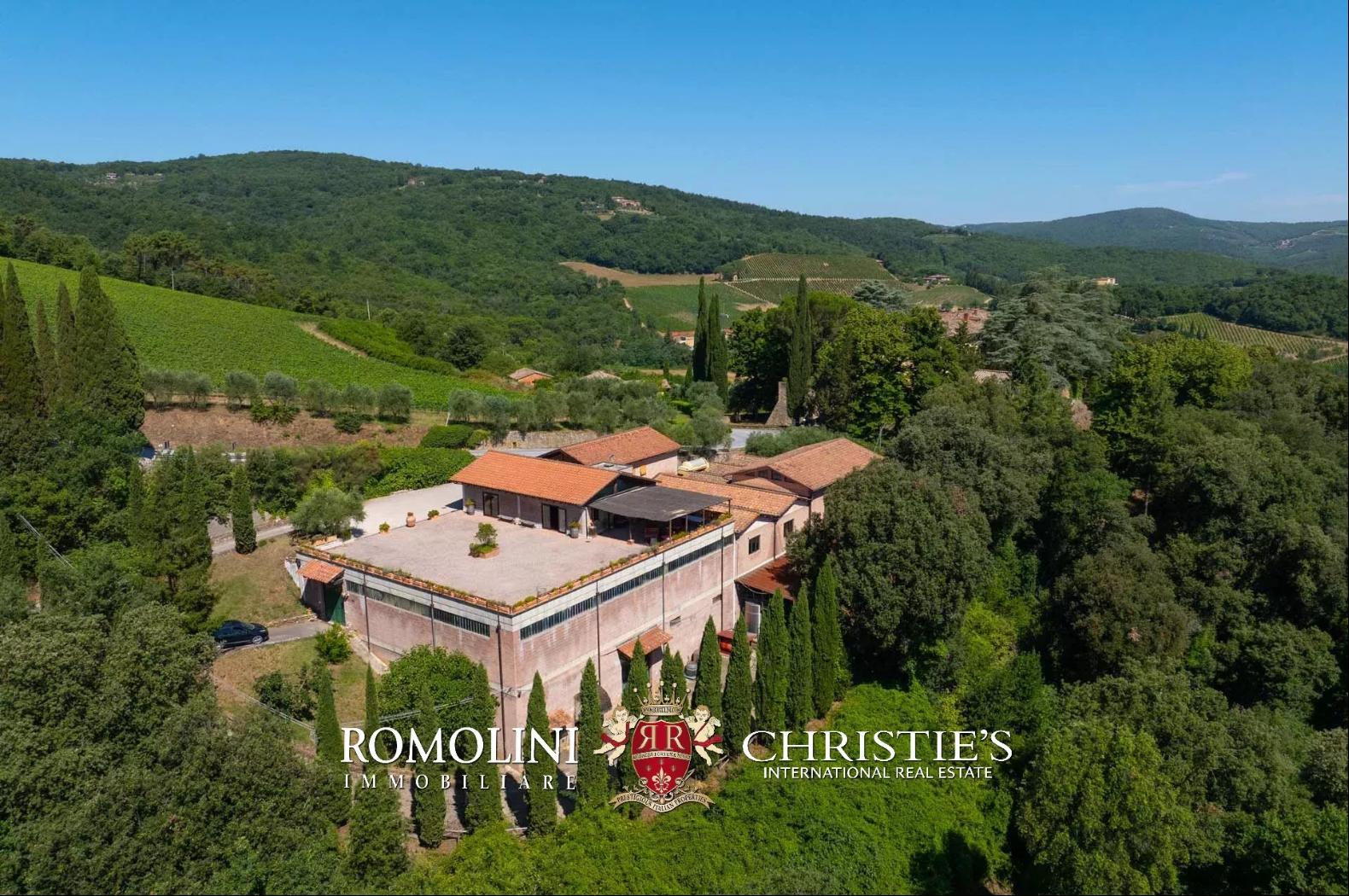
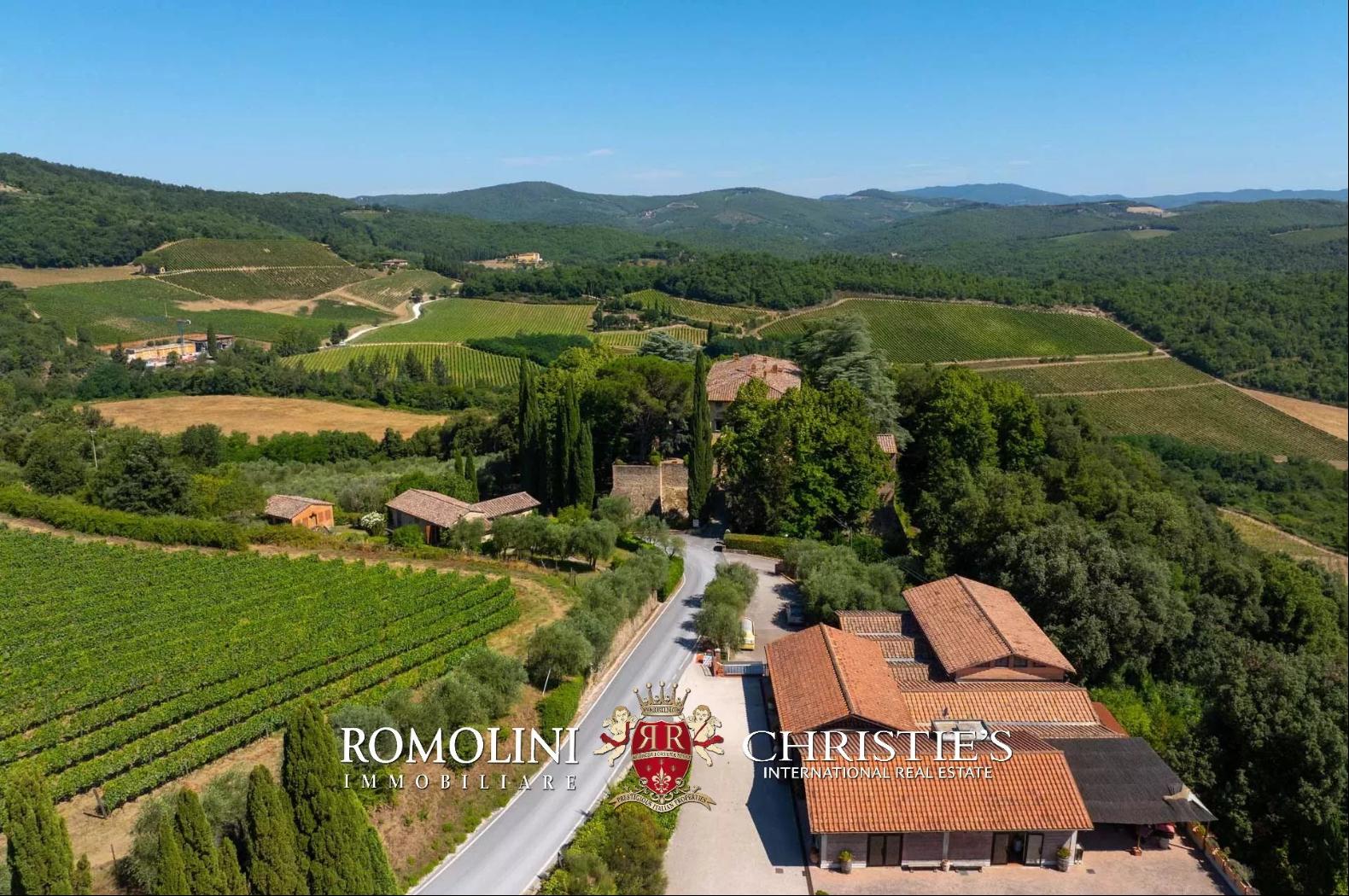
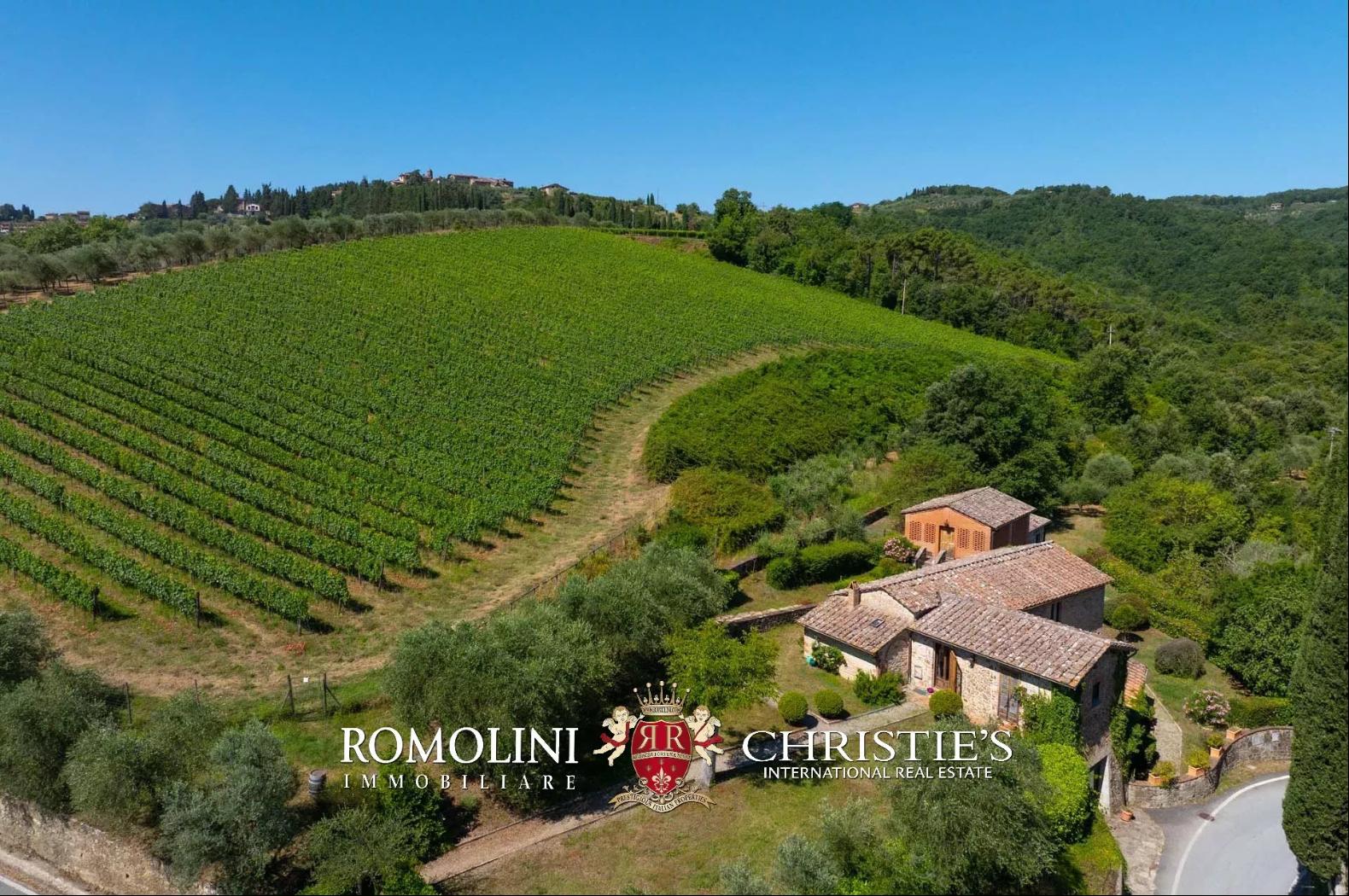
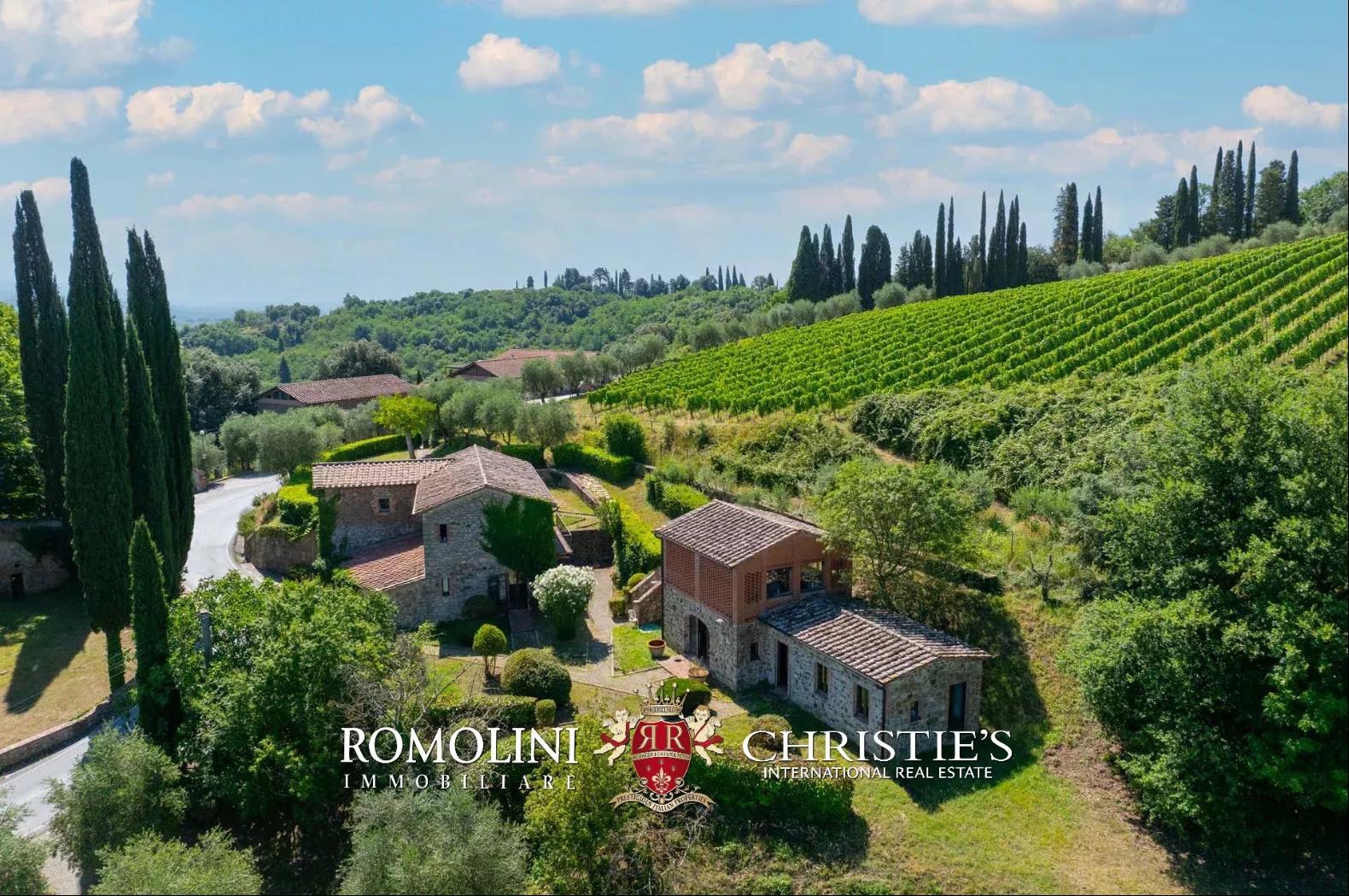
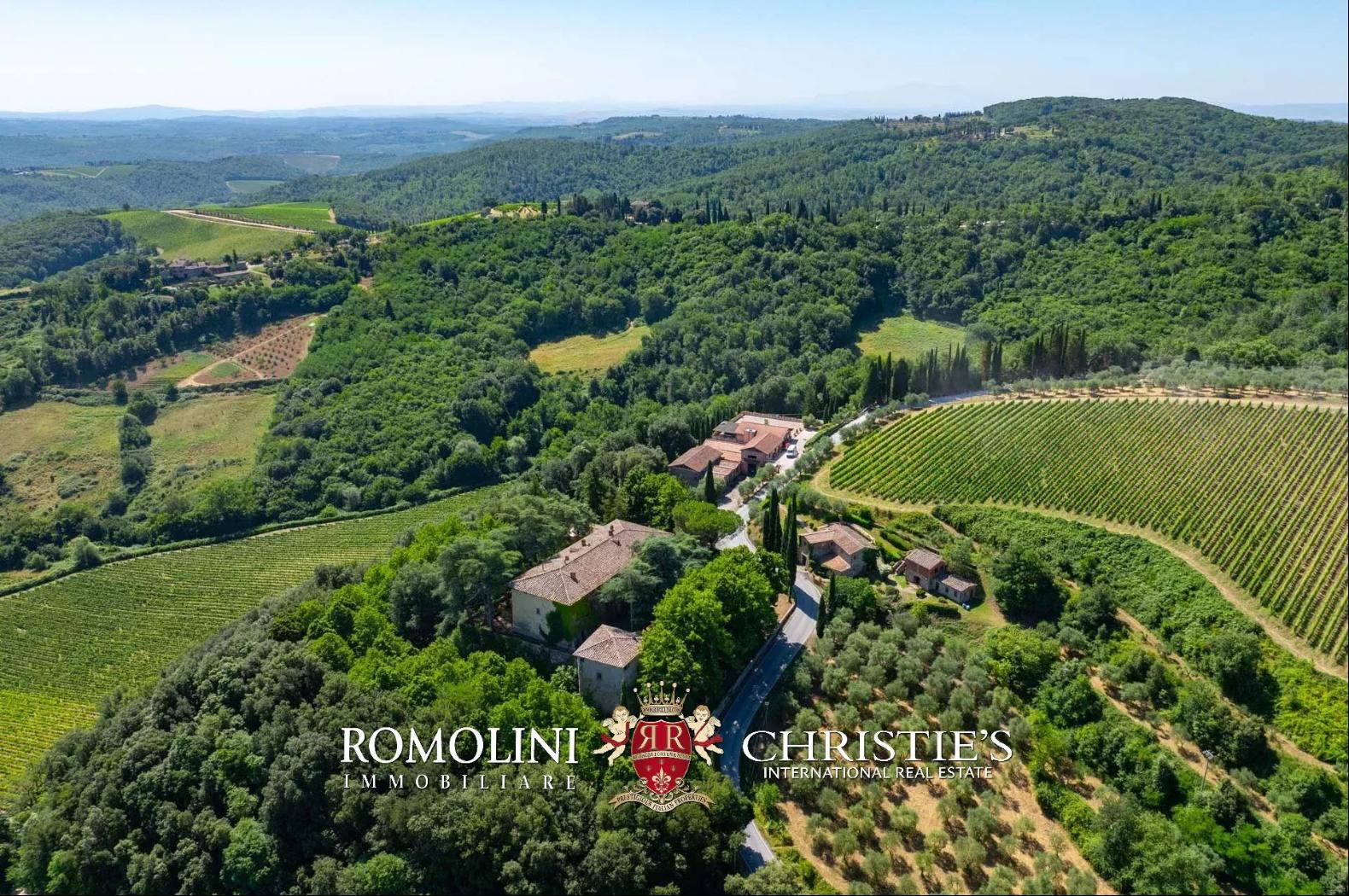
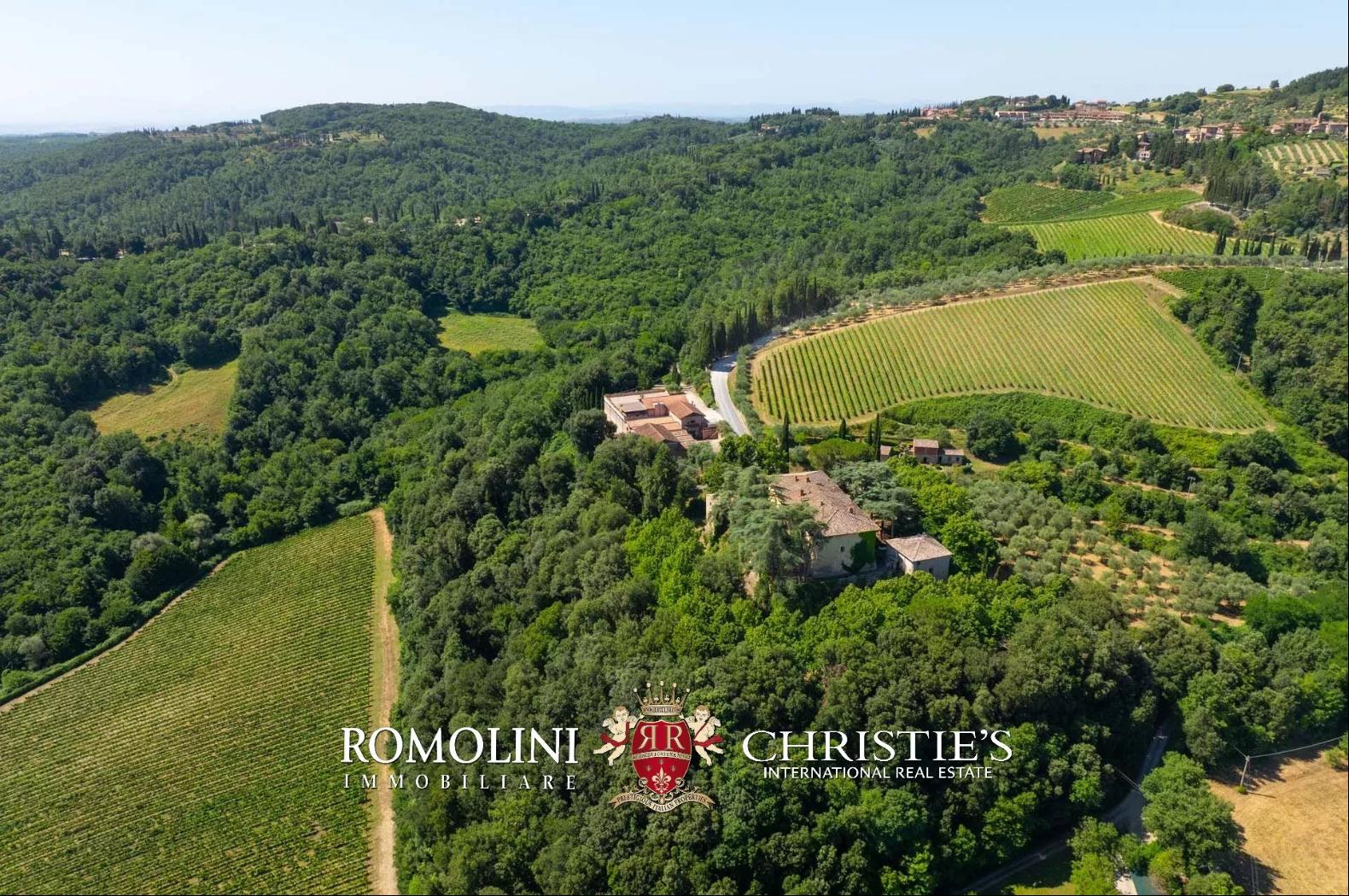
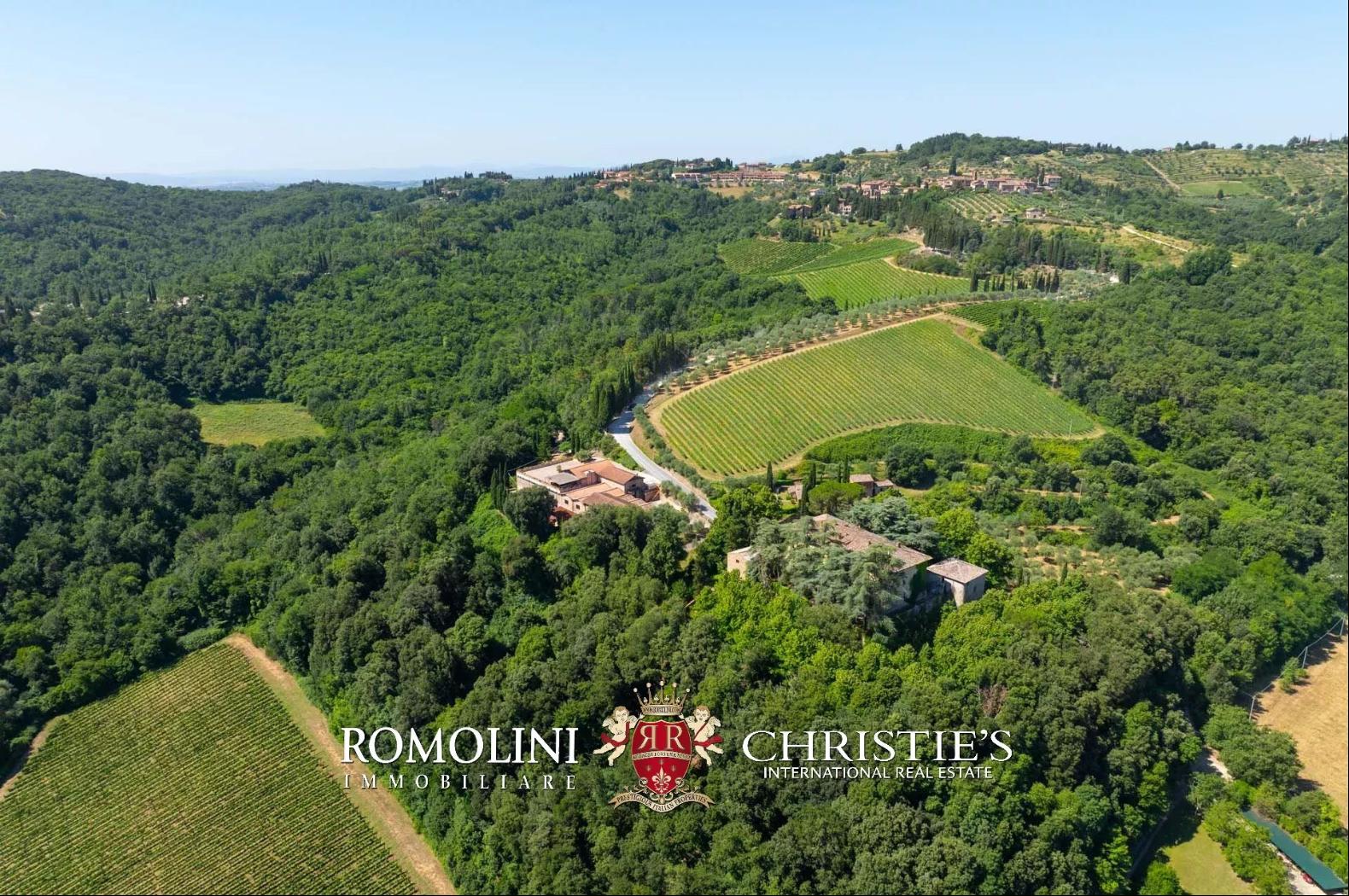
prev
next
- For Sale
- EUR 12,300,000
- Build Size: 46,822 ft2
- Property Type: Farm/Ranch/Plantation
- Bedroom: 33
- Bathroom: 32
On the hills of Chianti, not far from Castelnuovo Berardenga and Radda, 102.1-ha wine estate with manor villa and hamlet to be restored for sale. The property, which boasts an incredible history ranging from the Middle Ages to the present day, offers great potential for receptive tourist development to go hand in hand with wine production: in fact, the farm exploits 28.5 ha of vineyards to produce about 130,000 bottles of wine per year.
The renovation of the various buildings (over 4,500 sqm in total) would pave the way for the creation of a luxury boutique hotel in a very renowned area of Tuscany, less than an hour from Florence and Siena: the convenient location and beautiful spaces (both indoor and outdoor) would also allow the property to be exploited not only for seasonal rentals but also as a location for events, ceremonies, conferences and corporate conventions.
Basic services are available in the nearby medieval village (1km; 2') while for everything else you just need to reach Siena, less than half an hour's drive away. Tuscany's best-known art cities (Monteriggioni, San Gimignano, Pienza, Montepulciano...)
DESCRIPTION OF THE BUILDINGS, STATE AND FINISHES
The manor house (1,300 sqm – 13,988 sqft, up to 15 bedrooms and 15 bathrooms) is a large stately building dating from the 17th and 18th centuries, registered at the superintendence and currently unused. The large rooms on the ground floor were formerly used as a tasting area (with capacity for up to 80 guests) with guest bathrooms, professional kitchen and storage rooms. The upper floors are abandoned and need major renovation and restoration before they can be used.
The wine cellar (2,000 sqm – 21,520 sqft, 2 bathrooms) is a modern, large building structured on three floors and equipped with freight elevators between levels for easier transport of products.
- Ground floor: administrative offices, store with tasting corner, kitchen for preparation, warehouse, bathrooms and large panoramic terrace (potentially to be used as tasting area in summer);
- Underground level (–1) (with direct access for farm vehicles): winemaking rooms, bottling line, warehouse for storage of finished product;
- Underground level (–2): aging cellar, equipment storage, kitchen, changing rooms for employees and toilets.
Equipment in the winery includes twenty-four steel winemakers (10 hl each), oak barrels (with capacities ranging from 5 to 60 hl), Bucher presses, destemmers, grape collection tanks, air conditioning system, and miscellaneous machinery.
In front of the castle, a short distance from the access bridge, we find a rustic farmhouse (220 sqm – 2,367 sqft, 8 bedrooms and 8 bathrooms) currently disused but easily converted into a charming B&B. The building is laid over two floors and consists of eight spacious bedrooms, all with private bathrooms and direct access from the outside.
Next to the farmhouse is the old barn (105 sqm – 1,130 sqft), structured on two floors and formerly used as a common area for guests with a breakfast room, professional kitchen for food preparation, reception for guests, two bathrooms and a spacious independent common room on the upper floor.
In the midst of the vineyards, north of the manor house, is a small rural hamlet to be renovated consisting of two rustic farmhouses (340 sqm – 3,658 sqft and 360 sqm – 3,874 sqft, respectively, up to 10 bedrooms and 7 bathrooms), both on two floors, and an old animal stable (125 sqm – 1,345 sqft), very convenient as a tool storage. Under the vegetation, there used to be two agricultural storage buildings (25 sqm – 269 sqft in total) that could be rebuilt and/or used as cubage to expand the existing buildings.
The property is completed by a vehicle shed (55 sqm – 592 sqft) set at the edge of the vineyards.
HISTORY OF THE PROPERTY
The villa stands on the remains of a castle probably built in the 13th century by Siena to defend the area. By 1554 the (greatly expanded) fortress was owned by the Bellanti family, and under their leadership it succeeded in containing Florentine attacks in the area, thanks to the imposing 10-meter-high walls but also to the courage of the small garrison (25 men) stationed in the castle. The bastion was eventually forced to capitulate, as Florentine artillery had caused too much damage to the structure, but the Florentines paid a high price for their victory with the death of military engineer Giovanni Battista Belluzzi. The fall of the fortress did not mean the end for the estate: farming life continued, and in 1692 a tax payment on wine production at the "estate" is recorded.
On the remains of the castle, the manor house visible today was built (probably between the 18th and 19th centuries). The current appearance of the building dates to the early 20th century: an earthquake in fact damaged the villa in 1911, and much of the upper floors were removed to reduce the risk of collapse (to date, only ten of the forty rooms remain).
Of the original medieval structure, the quadrangular walls are still standing, albeit reduced in height, with the four corner towers rising above street level. Only two of the towers remain standing in their entirety (northwest and northeast corners).
In 1934 the impressive complex was purchased by a well-known Liberal Party politician and turned into a winery: the Chianti Classico produced even became the "wine of the house" at Palazzo Madama.
EXTERIOR
The winery spans approximately 102.1 hectares (252.3 acres) in total, lying on the rolling hills of Chianti. Pillars of the estate are undoubtedly the vineyard (28.5 ha divided into sixteen plots) and the olive grove (6.2 ha with plants of the Frantoio, Leccino and Moraiolo varieties). The company plans to plant an additional 3.8 ha of vineyards (with varieties to be defined) in addition to permits already obtained (expiring in 2025) for the planting of another 7.0 ha.
The remainder of the farm is then devoted to arable land (15.3 ha), woods (5.0 ha) and land pertaining to the buildings (1.6 ha) with gardens and maneuvering yards. A large private lake (about 10,000 sqm in surface) also insists on the arable land, which can be used to irrigate the fields and vineyards when needed.
The farm has been in organic conversion since 2021, with final certification scheduled for 2024.
DETAILS ON WINE PRODUCTION
- Vineyards: 28.5 hectares (70.4 acres)
- Varieties: Sangiovese (72%), Merlot (13%), Cabernet Sauvignon (6%), Colorino (4%), Chardonnay (2%), Sauvignon Blanc (3%)
- Altitude and exposure: 320 – 480 m asl (north, east, southeast, south)
- Years of planting: 1999 – 2019
- Training: pruned-spur cordon (4,000 – 5,000 vines / ha)
- Soil composition: sandy, clayish, sandstone
- Yearly production: 1,000 hl (about 130,000 bottles)
- Markets reached: Italy (65%), Canada, Japan, Germany, Denmark, Southeast Asia, U.S.A.
WINES PRODUCED
The winery produces numerous DOCG (4 labels) and IGT (6 labels) wines, all of excellent quality as evidenced by the excellent ratings received from James Suckling (94/100), Falstaff (92/100), Wine Critic (93/100) and Wine Align (91/100) and awards at events such as Concours Mondial de Bruxelles, Wine Hunter and Decanter. The wines are also featured in the most renowned wine guides such as Slow Wine, Veronelli, Weinwisser and Bibenda.
- Chianti Classico DOCG: Sangiovese 90%, Merlot, Colorino
- Chianti Classico DOCG Riserva: Sangiovese 100%
- Chianti Classico DOCG Riserva: Sangiovese 90%, Merlot, Colorino
- Chianti Classico DOCG Gran Selezione: Sangiovese 90%, Merlot, Colorino
- Toscana Rosso IGT: Sangiovese 70%, Merlot 30%
- Toscana Rosso IGT: Cabernet Sauvignon 70%, Sangiovese 30%
- Toscana Rosso IGT: Merlot 90%, Sangiovese 10%
- Toscana Bianco IGT: Sauvignon Blanc 70%, Chardonnay 30%
- Toscana Rosé IGT: Sangiovese 100%
- Spumante Brut Rosé IGT: Sangiovese 100%
CLOSEST CITIES AND TOWNS
Paese con servizi (1km; 2'), Radda in Chianti (10km; 15'), Castellina in Chianti (11km; 20'), Siena (16km; 30'), Gaiole in Chianti (16km; 25'), Monteriggioni (24km; 30'), Greve in Chianti (27km; 40'), Castelnuovo Berardenga (28km; 35'), San Gimignano (46km; 50'), Volterra (59km; 1h), Arezzo (70km; 1h 20'), Pienza (71km; 1h 20'), Montepulciano (76km; 1h 15'), Firenze (80km; 1h 15'), Cortona (85km; 1h 15')
CLOSEST AIRPORTS
Grosseto C. Baccarini (89km; 1h 20'), Firenze A. Vespucci (90km; 1h 15'), Pisa G. Galilei (124km; 1h 45'), Perugia San Francesco (129km; 1h 45'), Bologna G. Marconi (172km; 2h), Roma Ciampino (257km; 2h 55'), Roma Fiumicino (272km; 3h)
The renovation of the various buildings (over 4,500 sqm in total) would pave the way for the creation of a luxury boutique hotel in a very renowned area of Tuscany, less than an hour from Florence and Siena: the convenient location and beautiful spaces (both indoor and outdoor) would also allow the property to be exploited not only for seasonal rentals but also as a location for events, ceremonies, conferences and corporate conventions.
Basic services are available in the nearby medieval village (1km; 2') while for everything else you just need to reach Siena, less than half an hour's drive away. Tuscany's best-known art cities (Monteriggioni, San Gimignano, Pienza, Montepulciano...)
DESCRIPTION OF THE BUILDINGS, STATE AND FINISHES
The manor house (1,300 sqm – 13,988 sqft, up to 15 bedrooms and 15 bathrooms) is a large stately building dating from the 17th and 18th centuries, registered at the superintendence and currently unused. The large rooms on the ground floor were formerly used as a tasting area (with capacity for up to 80 guests) with guest bathrooms, professional kitchen and storage rooms. The upper floors are abandoned and need major renovation and restoration before they can be used.
The wine cellar (2,000 sqm – 21,520 sqft, 2 bathrooms) is a modern, large building structured on three floors and equipped with freight elevators between levels for easier transport of products.
- Ground floor: administrative offices, store with tasting corner, kitchen for preparation, warehouse, bathrooms and large panoramic terrace (potentially to be used as tasting area in summer);
- Underground level (–1) (with direct access for farm vehicles): winemaking rooms, bottling line, warehouse for storage of finished product;
- Underground level (–2): aging cellar, equipment storage, kitchen, changing rooms for employees and toilets.
Equipment in the winery includes twenty-four steel winemakers (10 hl each), oak barrels (with capacities ranging from 5 to 60 hl), Bucher presses, destemmers, grape collection tanks, air conditioning system, and miscellaneous machinery.
In front of the castle, a short distance from the access bridge, we find a rustic farmhouse (220 sqm – 2,367 sqft, 8 bedrooms and 8 bathrooms) currently disused but easily converted into a charming B&B. The building is laid over two floors and consists of eight spacious bedrooms, all with private bathrooms and direct access from the outside.
Next to the farmhouse is the old barn (105 sqm – 1,130 sqft), structured on two floors and formerly used as a common area for guests with a breakfast room, professional kitchen for food preparation, reception for guests, two bathrooms and a spacious independent common room on the upper floor.
In the midst of the vineyards, north of the manor house, is a small rural hamlet to be renovated consisting of two rustic farmhouses (340 sqm – 3,658 sqft and 360 sqm – 3,874 sqft, respectively, up to 10 bedrooms and 7 bathrooms), both on two floors, and an old animal stable (125 sqm – 1,345 sqft), very convenient as a tool storage. Under the vegetation, there used to be two agricultural storage buildings (25 sqm – 269 sqft in total) that could be rebuilt and/or used as cubage to expand the existing buildings.
The property is completed by a vehicle shed (55 sqm – 592 sqft) set at the edge of the vineyards.
HISTORY OF THE PROPERTY
The villa stands on the remains of a castle probably built in the 13th century by Siena to defend the area. By 1554 the (greatly expanded) fortress was owned by the Bellanti family, and under their leadership it succeeded in containing Florentine attacks in the area, thanks to the imposing 10-meter-high walls but also to the courage of the small garrison (25 men) stationed in the castle. The bastion was eventually forced to capitulate, as Florentine artillery had caused too much damage to the structure, but the Florentines paid a high price for their victory with the death of military engineer Giovanni Battista Belluzzi. The fall of the fortress did not mean the end for the estate: farming life continued, and in 1692 a tax payment on wine production at the "estate" is recorded.
On the remains of the castle, the manor house visible today was built (probably between the 18th and 19th centuries). The current appearance of the building dates to the early 20th century: an earthquake in fact damaged the villa in 1911, and much of the upper floors were removed to reduce the risk of collapse (to date, only ten of the forty rooms remain).
Of the original medieval structure, the quadrangular walls are still standing, albeit reduced in height, with the four corner towers rising above street level. Only two of the towers remain standing in their entirety (northwest and northeast corners).
In 1934 the impressive complex was purchased by a well-known Liberal Party politician and turned into a winery: the Chianti Classico produced even became the "wine of the house" at Palazzo Madama.
EXTERIOR
The winery spans approximately 102.1 hectares (252.3 acres) in total, lying on the rolling hills of Chianti. Pillars of the estate are undoubtedly the vineyard (28.5 ha divided into sixteen plots) and the olive grove (6.2 ha with plants of the Frantoio, Leccino and Moraiolo varieties). The company plans to plant an additional 3.8 ha of vineyards (with varieties to be defined) in addition to permits already obtained (expiring in 2025) for the planting of another 7.0 ha.
The remainder of the farm is then devoted to arable land (15.3 ha), woods (5.0 ha) and land pertaining to the buildings (1.6 ha) with gardens and maneuvering yards. A large private lake (about 10,000 sqm in surface) also insists on the arable land, which can be used to irrigate the fields and vineyards when needed.
The farm has been in organic conversion since 2021, with final certification scheduled for 2024.
DETAILS ON WINE PRODUCTION
- Vineyards: 28.5 hectares (70.4 acres)
- Varieties: Sangiovese (72%), Merlot (13%), Cabernet Sauvignon (6%), Colorino (4%), Chardonnay (2%), Sauvignon Blanc (3%)
- Altitude and exposure: 320 – 480 m asl (north, east, southeast, south)
- Years of planting: 1999 – 2019
- Training: pruned-spur cordon (4,000 – 5,000 vines / ha)
- Soil composition: sandy, clayish, sandstone
- Yearly production: 1,000 hl (about 130,000 bottles)
- Markets reached: Italy (65%), Canada, Japan, Germany, Denmark, Southeast Asia, U.S.A.
WINES PRODUCED
The winery produces numerous DOCG (4 labels) and IGT (6 labels) wines, all of excellent quality as evidenced by the excellent ratings received from James Suckling (94/100), Falstaff (92/100), Wine Critic (93/100) and Wine Align (91/100) and awards at events such as Concours Mondial de Bruxelles, Wine Hunter and Decanter. The wines are also featured in the most renowned wine guides such as Slow Wine, Veronelli, Weinwisser and Bibenda.
- Chianti Classico DOCG: Sangiovese 90%, Merlot, Colorino
- Chianti Classico DOCG Riserva: Sangiovese 100%
- Chianti Classico DOCG Riserva: Sangiovese 90%, Merlot, Colorino
- Chianti Classico DOCG Gran Selezione: Sangiovese 90%, Merlot, Colorino
- Toscana Rosso IGT: Sangiovese 70%, Merlot 30%
- Toscana Rosso IGT: Cabernet Sauvignon 70%, Sangiovese 30%
- Toscana Rosso IGT: Merlot 90%, Sangiovese 10%
- Toscana Bianco IGT: Sauvignon Blanc 70%, Chardonnay 30%
- Toscana Rosé IGT: Sangiovese 100%
- Spumante Brut Rosé IGT: Sangiovese 100%
CLOSEST CITIES AND TOWNS
Paese con servizi (1km; 2'), Radda in Chianti (10km; 15'), Castellina in Chianti (11km; 20'), Siena (16km; 30'), Gaiole in Chianti (16km; 25'), Monteriggioni (24km; 30'), Greve in Chianti (27km; 40'), Castelnuovo Berardenga (28km; 35'), San Gimignano (46km; 50'), Volterra (59km; 1h), Arezzo (70km; 1h 20'), Pienza (71km; 1h 20'), Montepulciano (76km; 1h 15'), Firenze (80km; 1h 15'), Cortona (85km; 1h 15')
CLOSEST AIRPORTS
Grosseto C. Baccarini (89km; 1h 20'), Firenze A. Vespucci (90km; 1h 15'), Pisa G. Galilei (124km; 1h 45'), Perugia San Francesco (129km; 1h 45'), Bologna G. Marconi (172km; 2h), Roma Ciampino (257km; 2h 55'), Roma Fiumicino (272km; 3h)


